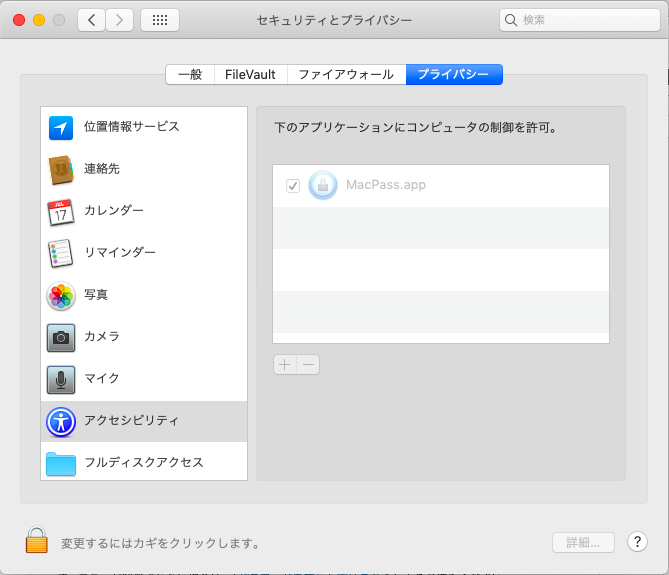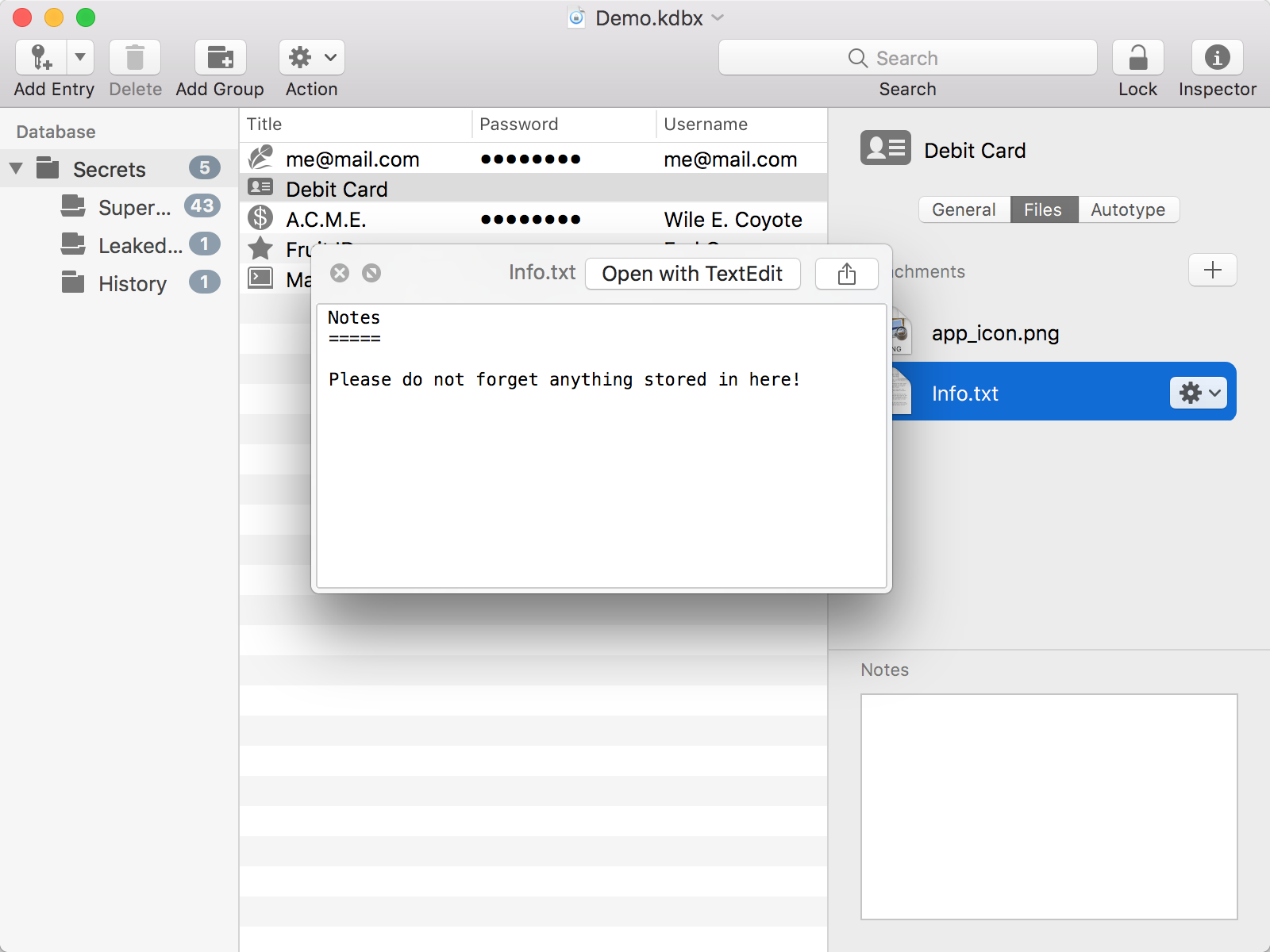How To Manage Your Passwords With Macpass
KeePass Adding Password Entry KeePass is a free open source password manager, which helps you to manage your passwords in a secure way. You can put all your passwords in one database, which is locked with one master key or a key file. Password Management. Toggle navigation Application Menu. Home; Change current password; Forgot password? MacPass can remember all these passwords for you, while you only have to remember the master password that will unlock access to your password manager. The program stores your passwords in a highly encrypted database. This database consists of only one file, so it can be easily transferred from one computer to another. How to install MacPass? To view the privacy statement visit MACPASS.com. MAP.com You can manage your account online 24 hours a day at MACPASS.com. Use this website to: update your personal information, make payments, request an additional MACPASS, print your airport parking receipts, and more. Monthly statements can be emailed automatically,.
How often do you find yourself struggling to come up with new login credentials, only to forget them afterward? Managing passwords for every account, site, and service can certainly get frustrating at times. Even more so, if you consider that the number of internet devices and online accounts in use is constantly growing.
It is essential to make sure each of your passwords is secure. This, in turn, requires that you understand how to manage passwords properly, why it’s so important, and what makes a password strong. In this Passwarden® blog post, we'll discuss exactly that!
Why Managing Strong Passwords is Important
Hackers can use a vast array of techniques and tools to gain access to your sensitive information. However, most often a security breach occurs through one of two attack vectors: either via a brute-force attack or by exploiting the victim’s negligence of security measures. In both scenarios, the attacker’s job is all the easier if the victim uses simple, short, and common passwords.
The dangers of weak passwords

What exactly is wrong with weak passwords? We’re going to explore this in the following paragraphs, but for now, here’s a bit of password management trivia for you. One of the most commonly used passwords is '123456789', which is by accident also one of the most commonly hacked ones. Think about it.
Of course, we genuinely believe that your password is stronger than that. But if you think about some of the first passwords that come to your mind, upon closer inspection you may find them wanting in terms of strength. Our passwords tend to include at least some of our personalized details - names, birthdays, schools and graduation years, kid and pet names, sports team and favorite band names, etc.

Unfortunately (but not unexpectedly), many of these details are by no means unique enough. Hackers have long been utilizing curated lists of words and phrases that are commonly used in passwords. This allows them to organize global attacks, targeting large groups of people at once. And the most likely first victims of such attacks are users with weak or common passwords.
Passwords and brute-force attacks
One of the most common types of attacks aimed at breaching into user accounts and stealing personal data is aptly named a brute-force attack. In it, a hacker uses a program that attempts to systematically enter every possible combination in an attempt to basically “guess” your password by trial and error. It might feel like this would take forever, but with a powerful enough computer, and with a weak password, a brute-force attack can crack it in minutes or hours.
Now, it must be noted that no password is totally uncrackable. The only difference between a weak and a strong password is that the latter takes more time to crack. However, this is a vital difference! While a weak password will take a couple of hours to crack, a long, complex, and unique password will take hundreds of years, rendering any attack futile.
3 Rules for Managing Strong Passwords
1. Variety of characters
Creating a strong password is not as difficult as one might think. The first step is to use different types of characters in your password (numbers, special symbols, upper and lowercase letters), which makes it significantly more reliable. By adding even a single character of a different type, you increase the list of potential combinations that an attacker has to try. The more complex the combination of characters - the better.
2. Password length
A healthy mix of characters makes a password more reliable, but making it even a few characters longer increases its security manifold. How long should a password be? The general consensus is - at least 10+ digits long if it combines various types of characters, or at 15+ otherwise. Adding just 3 extra characters to a weak password can increase the time it takes to crack it from hours to centuries.
3. Password uniqueness
Ah, the painful topic of reusing passwords. Most of us know it’s a bad habit, and yet we often opt to do reuse a password or two nonetheless. Just to recap, why should you use unique passwords? Because otherwise if a security breach reveals a password on one of your accounts, it automatically jeopardizes all the others where you use the same password. And coincidentally, the first thing a hacker does when they get their hands on your password is to try it on every other account and email that belongs to you.
Using a Password Manager for Strong Passwords
To sum up the above, a strong password should be long enough, contain a variety of types of characters, and be unique. Here’s a random example of a strong password, generated in Passwarden: F*j9upoFj)7f2agkvz. Now imagine you have something similar for a password per each of your accounts. This raises a valid question: how are you supposed to remember all those? Well, you aren’t - a password manager should do it for you!
A cloud-based password manager like Passwarden is a helpful tool that allows you to:
- Securely store your passwords, along with other sensitive information (logins, ID card, Driver’s License, SSN, credit cards and banking information, etc.)
- Conveniently manage and easily retrieve the stored data when needed (password autofill option included)
- Add extra layers of security with Two-Factor Authentication and Duress Mode
- Generate strong passwords and instantly save them in protected vaults
- Safely share your passwords and data with others
- Ensure the privacy of your information thanks to the zero-knowledge architecture
Read more:How do password managers work?
How to Manage Passwords With Passwarden
Using a dedicated app to manage passwords comes with its pros and cons. However, anyone who’s concerned about the security of their passwords and data would do well to use a password manager. As opposed to other, less reliable means, e.g. writing passwords down on sticky notes or digital sheets.
How to start using Passwarden
Our password manager is really easy to take up! You can download and use it or free right now using the free subscription. You can also check out Passwarden paid subscriptions for more advanced options.
How To Manage Your Passwords With Macpass Yahoo
Once you sign in with a new or existing KeepSolid ID, you will be prompted to create a Master Password. This is a very important step! Master Password is your key to Passwarden, which means two things:
- You want to make sure that it’s well-protected - strong enough to withstand a brute-force attack, and reinforced with two-factor authentication
- You don’t want to lose it - without it, not even Passwarden’s employees can access your data (see how to recover your Master Password)
With your newly created Master Password, you’ll be able to access your Passwarden account and start managing your passwords and sensitive information in Vaults. A Vault is a single, separate storage place. You can create any number of Vaults for different purposes (e.g. a personal Vault for your own data and a shared Vault for your family account passwords).
How to manage saved passwords
What if you wanted to use Passwarden to manage passwords that you already have stored in other apps, for example in a browser? In this case, you could utilize the Data Migration feature. It allows you to import passwords from different apps directly to Passwarden. This is a very convenient option since otherwise, you’d have to manually transfer what could easily be thousands of passwords!
How to manage passwords on Mac, iPhone, Chrome, Safari, and other devices
With Passwarden, you can manage passwords on all popular platforms, including macOS, iOS, Windows, Android, browsers, and using the web app. Moreover, you can use Passwarden on any number of devices simultaneously. And with the cloud-based data synchronization, any passwords that you save on one of your devices will instantly become available on all the others where you’re signed in to your Passwarden account.
Mobile Device Management (MDM) is an industry term for the administration of mobile devices, such as smartphones, tablets, laptops and desktop computers.
Mac Desktop Service uses a commercial MDM system to provide the Mac Self-Service. In addition, the MDM enables the Managed iOS scenario, within which local administrators can manage iOS devices (i.e. iPads or iPhones) in their teams.
How To Manage Your Passwords With Macpass Wifi
If you think you could benefit from the MDM capabilities, please contact the Mac Desktop Service via the Service Desk.
Technically, on Mac OS X, the MDM requires an installation of an agent which runs with local admin privileges on the Mac in order to automate installations, manage software dependencies and gather information about the hardware and software on the Mac. On iOS devices, the management capabilities implemented over the Apple Push Notification Service are built in the operating system and do not require an agent on the device. In both cases, the relationship between the device and the MDM system begins when the owner of the device enrols the device in the MDM.
If the device on which you intend to install this software is owned by an external university or institute, please ensure that you have the right to authorise the installation.
The MDM for Mac OS X and iOS is currently provided as a pilot service.
